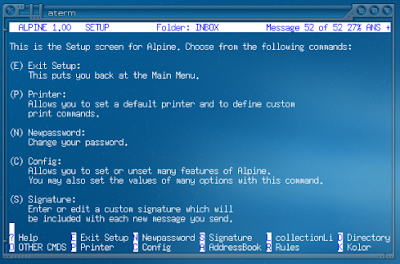 Alpine Linux is a community developed operating system designed for x86 routers, firewalls, VPNs, VoIP boxes and servers. It was designed with security in mind; it has proactive security features like PaX and SSP that prevent security holes in the software to be exploited.
Alpine Linux is a community developed operating system designed for x86 routers, firewalls, VPNs, VoIP boxes and servers. It was designed with security in mind; it has proactive security features like PaX and SSP that prevent security holes in the software to be exploited.The C library used is uClibc and the base tools are all in BusyBox. Those are normally found in embedded systems and are smaller than the tools found in GNU/Linux systems.
Alpine originally stood for A Linux Powered Integrated Network Engine. The idea was that the distro would be focused on networking, and be a tiny "engine" or framework upon which larger systems could be built. Today, Alpine lives up to that name.
The first open source implementation of Cisco's DMVPN, called OpenNHRP, was written for Alpine Linux. Improvements to networking functions in the Linux Kernel have started from patches and the needs of the Alpine Linux team.
In addition to its use as a firewall/router, Alpine Linux is also used in a number of installations as the basis for enterprise servers, running software such as PostgreSQL, Postfix, Asterisk, Kamailio, and being used for iSCSI SANs. It is the little engine that could.
Updates: (via Distrowatch)
Natanael Copa has announced the release of Alpine Linux 2.2.0, a community developed operating system designed for x86 routers, firewalls, VPNs, VoIP boxes and servers: "The Alpine Linux project is pleased to announce immediate availability of version 2.2 of its Alpine Linux operating system. This release introduces several new features: a new Linux kernel branch based on 2.6.38 with all of the Alpine patches either re-based or included in upstream Linux sources; new support for the x86_64 architecture; SHA512 password hashing security; preliminary support for grsecurity Role Based Access Control; enhanced disk partitioning and installation tool (setup-disk); improved package management tools (apk); support for read-only boot file systems; added GNOME desktop environment...."
Read the full release notes for additional information and package changes.
Download: alpine-2.2.0-x86.iso (213MB, SHA1), alpine-2.2.0-x86_64.iso (230MB, SHA1).
• 2011-05-04: Distribution Release: Alpine Linux 2.2.0
• 2011-03-09: Distribution Release: Alpine Linux 2.1.5
• 2011-01-09: Distribution Release: Alpine Linux 2.1.4
• 2010-11-04: Distribution Release: Alpine Linux 2.1.0
• 2010-08-21: Distribution Release: Alpine Linux 2.0.0
Install Alpine on VirtualBox.
Start by creating new VM and setting it to run linux with 2.6 series kernel.
Set amount of memory. Since alpine runs in memory the recommended 256 MB might be too little for your needs.
Create a disk. I wanted to emulate a Compact Flash system, so the setting is 2GB. This could be much higher if you like.
Install Alpine.
After Alpine boots type root to login.Find out the virtual harddisk ID.
dmesg | grep disk
With default settings in the VirtualBox this will be sda. I made the actual installation using CF installation instructions, but basic HD installation should work too.
Note: With CF install remember to edit
/media/sda1/syslinux.cfg to boot from the HD (alpine_dev=sda1:vfat) vi
/media/sda1/syslinux.cfg
/media/sda1/syslinux.cfg
Configure Installation.
halt
After Alpine has been stopped, unmount the CD image in VirtualBox (Devices menu).Start the virtual machine again and it should now boot from the virtual disk.
Setup Alpine:
setup-alpine
Configure Alpine local backup to use the virtual disk:
Edit
/etc/lbu/lbu.conf to have line: LBU_MEDIA=sda1Commit your setup:
lbu commit
Optional: to debug any problems in startup, activate the rc-system logging:
echo 'rc_logger="YES"'
>> /etc/rc.conf
Results will be in >> /etc/rc.conf
/var/log/rc.logSetup Alpine package management to cache any downloaded packages in the HD:
mkdir /media/sda1/cache
ln -s /media/sda1/cache
/etc/apk/cache
/etc/apk/cache
lbu commit
Setup APK to use a network source and update your system:
apk update
apk upgrade
lbu commit
Development Environment.
I use VirtualBox to compile and test programs for a actual Alpine box. To setup a compilation environment: apk add alpine-sdk
lbu commit
I also like to save any local files to survive next boot:
lbu add usr/local
lbu commit
Screenshots.















ReplyDeleteI’ve just had a little play with this and it seems fantastic for its purpose. Combining an up to date Linux kernel with grsec and PaX seems to have already proven itself out in the wild and there’s none of the fluff so you can build tiny appliances designed to do tasks securely and quickly.
It’s nice. It’s great that it boots off an .iso if required as well.
It’s so nice that we’ve now packaged it up to work with our VPS auto-installer on our Alpine Linux VPS page. It installs in a jiffy as it’s so small.